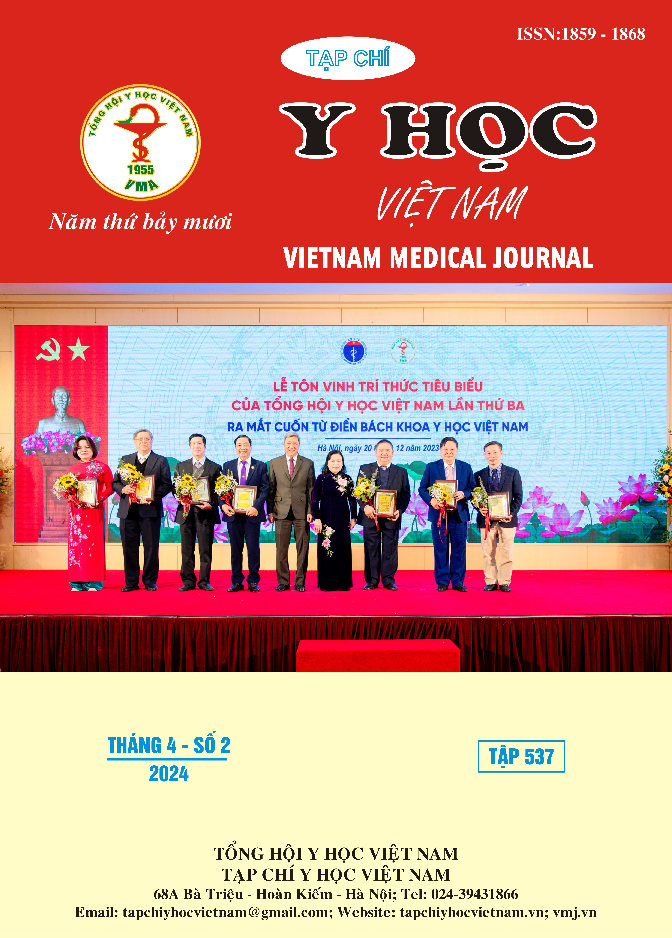DESCRIPTION OF CHARACTERISTICS OF EEG AND MAGNETIC RESONANCE IMAGING IN CHILDREN WITH DRUG-RESISTANT EPILEPSY
Main Article Content
Abstract
Objective: Analyze some characteristics, electroencephalogram, magnetic resonance imaging, determine risk factors for drug-resistant epilepsy in children. Subjects and methods: Cross-sectional descriptive study of 213 children with epilepsy treated at the neurology department of the National Children's Hospital and the neurology department of Nghe An Obstetrics and Pediatrics Hospital from January 2021 to December 2022, divided into 2 groups: drug-resistant (n=112) and drug-responsive (n=101) epilepsy group. Patients were diagnosed with drug-resistant epilepsy and responded to medication according to criteria (ILAE 2010). Results: 213 patients studied. The drug-resistant epilepsy group had status epilepticus accounting for 25.9%, neonatal convulsions accounting for 15.2%, febrile seizures accounting for 35.7%, and psychomotor developmental delay accounting for 93.8%. The average age of onset in the drug-resistant epilepsy group was 11.8 ± 13 months, the average frequency of seizures in the drug-resistant epilepsy group in 1 day was 10.6 ± 8.6. Clinical classification of generalized epilepsy accounted for 70.9% in both study groups. There were 34 cases classified as syndrome, accounting for 16%. The results of paraclinical analysis of EEG and brain MRI were abnormal in the drug-resistant epilepsy group, accounting for 93% and 58.9%, respectively. Conducting multivariate regression analysis showed that neonatal seizures, febrile seizures, status epilepticus, delayed psychomotor development, abnormal electroencephalogram and MRI are factors related to epilepsy. drug resistance. Conclusion: Abnormal brain MRI and EEG wave results combined with clinical factors such as history of neonatal seizures, history of febrile seizures, status epilepticus, delayed psychomotor development milestones, increasing the risk of drug-resistant epilepsy in children
Article Details
Keywords
Epilepsy, drug-resistant epilepsy, electroencephalogram, magnetic resonance
References
2. Granata T, Marchi N., Carlton E. (2009). Management of the patient with medically refractory epilepsy. Expert Review of Neurotherapeutics, 9(12), 1791–1802.
3. Rocque B.G, Davis M.C., McClugage S.G. (2018). Surgical treatment of epilepsy in Vietnam: program development and international collaboration. Neurosurgical Focus, 45(4), E3.
4. Wu C.-C, Tsai M.-H., Chu Y.-J. (2020). The role of targeted gene panel in pediatric drug-resistant epilepsy. Epilepsy & Behavior, 106, 107003.
5. Sporiš D, Bašić S, Šušak I. (2013). Predictive factors for early identification of pharmacoresistant epilepsy. Acta clinica Croatica, 52(1.), 11–15.
6. Karaoğlu P, Yi̇Ş U., Polat A.İ. (2021). Clinical predictors of drug-resistant epilepsy in children. Turk J Med Sci, 51(3), 1249–1252.
7. Patil M.G, Malik S, Joshi S. (2009). Early predictors of intractable childhood epilepsy. Bombay Hospital Journal, 51(1), 37.
8. Oskoui M, Webster R.I, Zhang X. (2005). Factors predictive of outcome in childhood epilepsy. Journal of child neurology, 20(11), 898–904.
9. Mohanraj R. Brodie M.J. (2013). Early predictors of outcome in newly diagnosed epilepsy. Seizure, 22(5), 333–344.


